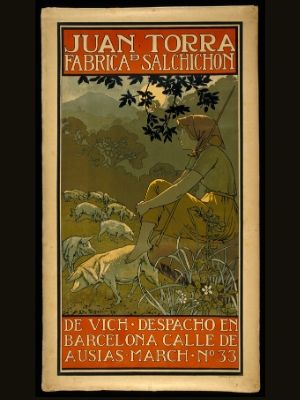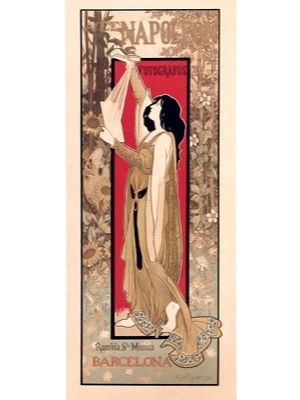Adela Laborda
In 1893 the artist, writer, collector and pioneer of Modernista graphic arts in Catalonia, Alexandre de Riquer (Calaf, 1856 – Palma, 1920), put a masterpiece up for sale that is now in the Museu Nacional d’Art de Catalunya’s Renaissance and Baroque collection: The Martyrdom of Saint Bartholomew (1644), by Jusepe de Ribera, “lo Spagnoletto” (Xàtiva, 1591 – Naples, 1662).
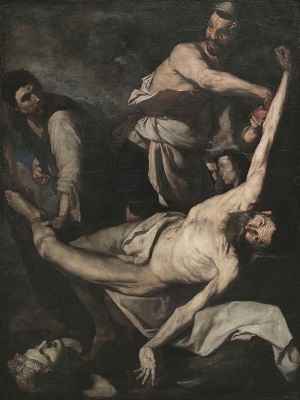
The painting is based on the Golden Legend by Jacobus de Varagine and it depicts the moment when the apostle Saint Bartholomew is being administered the terrible punishment of being flayed alive for having preached Christianity. One of the executioners is still tying him up, but the other one has already begun to flay him, with delight. This can be seen in the cheerful expression on his face, which contrasts with the face of the saint, who is looking straight at the viewer, perhaps asking for compassion.
A follower of Ribera and known above all for the pre-Romantic landscapes that he did throughout his career, Salvator Rosa (Naples, 1615 – Rome, 1673) painted another magnificent Martyrdom of Saint Bartholomew that is now in the Graf Harrach’sche Familiensammlung (Schloss Rohrau). There can be no doubt that this work, previously attributed to “Lo Spagnoletto”, was the principal reference that Alexandre de Riquer used in 1896 when composing the poster J. Torra sausage factory, Vich (private collection).
- Salvator Rosa, The Martyrdom of Saint Bartholomew, probably before 1640, Graf Harrasch’sche Familiensammlung, Schlossmuseum, Rohrau
- Alexandre de Riquer, J. Torra cured sausage factory, Vich, 1896, Museu Nacional d’Art de Catalunya
In “Sobre els cartells d’Alexandre de Riquer i les seves fonts” (Concerning the Posters of Alexandre de Riquer and their Sources, 1995), Rafael Cornudella demonstrated the origins of other posters made by Riquer in 1896. Thus, 3rd Exhibition of Fine Arts and Artistic Industries (Museu Nacional), considered to be the first Catalan Modernista poster, refers to a relief by the pre-Raphaelite sculptor George Frampton reproduced in the October 1893 issue of The Studio, a publication to which the artist was a subscriber. For its part, the early Art Nouveau that centres A. y E. F. Napoleón photographers (private collection) is indebted to two bookplates by H. Isabel Adams reproduced in Norna Labouchere’s collection, Ladies’ Book-plates (London, 1895), of which Riquer had a copy.
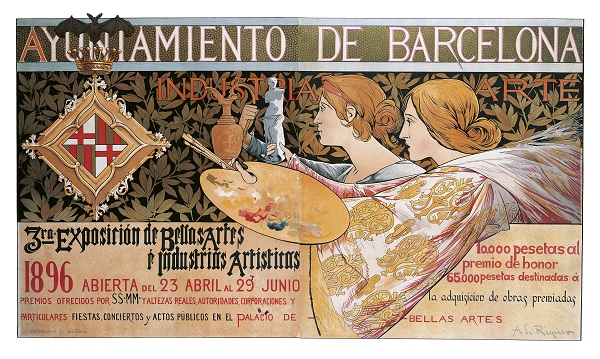
In the case of J. Torra cured sausage factory, Vich, Alexandre de Riquer abandons the British late pre-Raphaelite models that he had adopted as a result of his first trip to London in 1894 and took his inspiration, we believe, not only from a print, a reproduction of the work by Salvator Rosa – a print that we have not yet been able to identify – but also from a fairly popular etching of The Martyrdom of Saint Bartholomew, signed “Jusepe de Riuera Spañol”, and which bears the inscription “Dedico mis obras y esta estampa al SereniSmo Principe Philiberto mi Señor / en Napoles año 1624” (I dedicate my works and this print to the Most Serene Prince Filibert my lord / in Naples year 1624). This is revealed by the position of the head, the torso and the arms of the butcher who is tying the piglet on a board, with its head upwards – a position taken from the work by Rosa – and the motif of the bloody knife he is holding between his teeth – borrowed from Ribera.
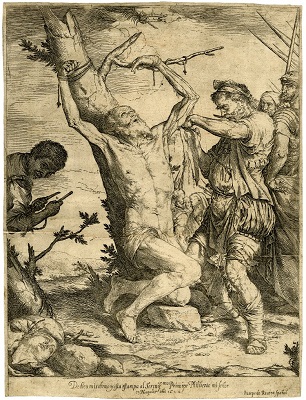
Bearing in mind that the work by Salvator Rosa had previously been attributed to Ribera – an attribution that Riquer was perhaps aware of – J. Torra cured sausage factory, Vich may be interpreted as an homage that the Catalan artist wished to pay Ribera, whose painting The Martyrdom of Saint Bartholomew he owned from 1893, at the latest.
At the same time, Cured sausage factory is almost certainly the most realistic poster of all those done by Riquer. Exhibited at the 3rd Exhibition of Fine Arts and Artistic Industries in 1896, the historian and critic Salvador Sanpere i Miquel, not a great admirer of Modernisme, called it “magnificent” and referred to it in the following way:
«Uno de esos degenerados [cartellistes] de seguro hubiera encontrado ocasion de ofrecernos […] alguna porquería, aunque no fuera mas que una de aquellas desdichadas concurrentes al Clou ó al Moulin Rouge de Paris, en donde van á inspirarse los modernistas, […] pero el señor de Riquer nos ha presentado un matarife en el acto del sacrificio, y como dicho señor no es un degenerado […] se ha abstenido, como manda el arte clásico que resplandece en toda su magnífica composición, de todo detalle repugnante. En fin, un premio de honor en punto á carteles […] nosotros, si hay que pasar la frontera, si no vamos á Grecia nos quedamos en Italia.» (El Diluvio, 3/6/1896, p. 10).
- Alexandre de Riquer, Fabrica de salchichon de Vich Juan Torra, 1899
- Alexandre de Riquer, A. y E. F. Napoleón fotógrafos, 1896, col·lecció particular
Although 3rd Exhibition of Fine Arts and Artistic Industries is a work with an oblong format – Riquer rejected the measurements stipulated in the rules of the competition – J. Torra cured sausage factory and A. y E. F. Napoleón photographers share the same vertical arrangement and the presence of a central box in which the figures are framed, surrounded by a decorative border. In the bottom of the frame of Cured sausage factory we see the trademark of the firm that Joan Torra Palou founded after breaking away from the commercial firm Torra y San and from its successor, Francesc Robert Yarzábal. In 1883 Torra y San had opened a shop – which is no longer there – in Barcelona, in the arcade of Palau Moja, and which was praised in the newspapers for both the select cooked meats that it sold – made in Vic – and for its interior decor, the direction of which was entrusted to Lluís Domènech i Montaner. Later, when Torra set up on his own, he commissioned Enric Sagnier – assisted by the master builder Josep Ylla Cortinas – to build a new cooked meats factory in Vic. This is an outstanding Modernista industrial building, dating to between 1896 and 1897, which is now the home of the city’s Visual Arts Centre and still has figures of piglets in the windows on the front.
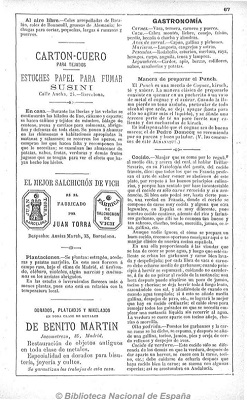
Joan Torra must have been pleased with Riquer’s poster, since, besides including reproductions of it in the Anuario-Riera from 1898 onwards, in 1899 he entrusted the artist with another work, Juan Torra cured sausage factory, Vich (Museu Nacional) which was exhibited in the Sala Parés at the end of the year.

The critic in La Publicidad observed that, “A moonbeam delicately picks out the profile of a countrywoman grazing a herd of pigs [a work] with a masterly effect [that] does justice to its maker’s reputation. [The poster] rivals the previous one and it will surely be purchased by everyone who appreciates this type of artistic work” (10/12/1899, p. 2). As Cornudella pointed out, the composition is based on The Century. Midsummer holiday number. August (1897), an advertising poster made by the well-known American artist Maxfield Parrish. Originally in the Riquer collection, it is conserved in the Museu Nacional, as are the books, magazines, prints, bookplates and posters that he kept in his splendid library and which were purchased from the artist’s heirs in 1921.
Related links
Alexandre de Riquer. Graphic work
Gabinet de Dibuixos i Gravats



